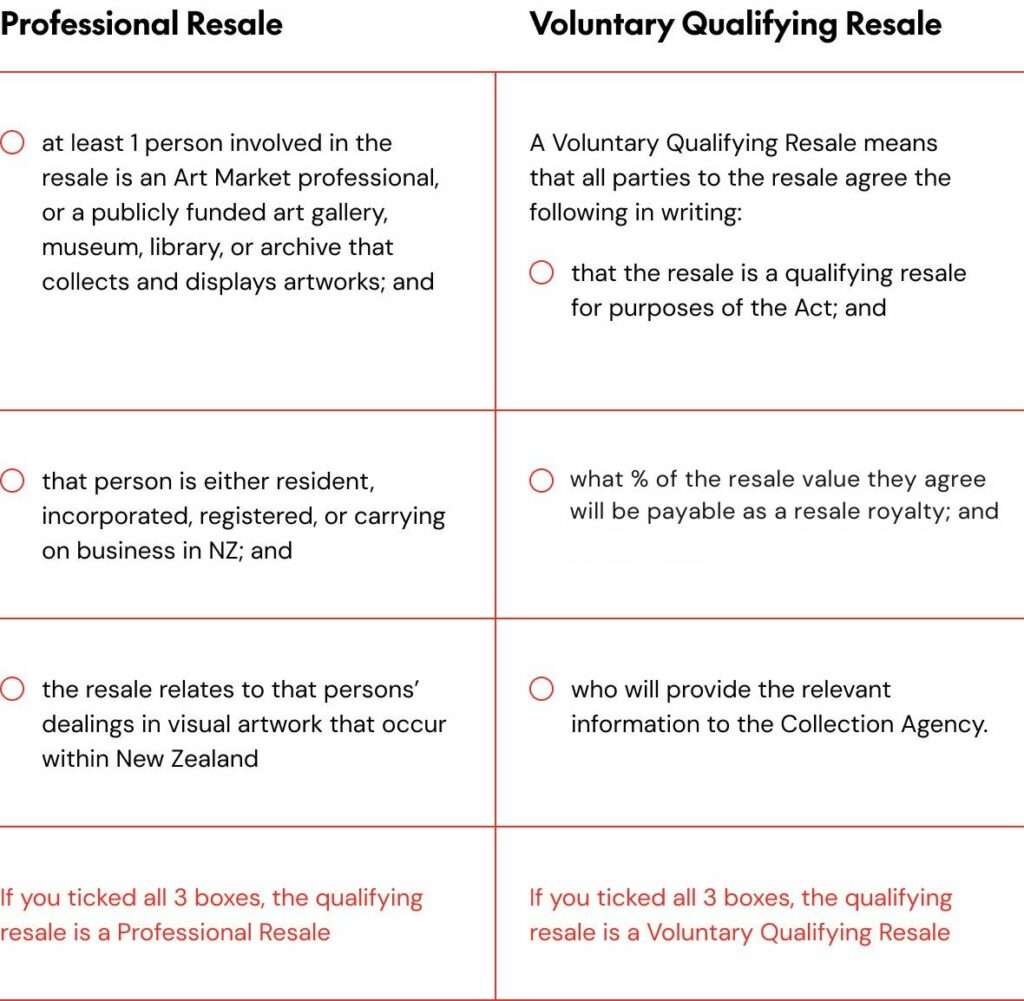The resale royalty payable is calculated at 5% of the “resale value” of the qualifying resale (section 16).
Section 10 says that “resale value” means: “the value of the consideration given for the visual artwork under the contract for resale” which may include:
- the amount paid in New Zealand dollars;
- the value of goods and/or services paid in kind;
- (if paid in another currency), the amount converted to NZD at the date of payment.
‘Resale value’ does not include:
- goods and services tax (GST; or
- duties, levies, or taxes (etc) under the Customs and Excise Act 2018; or
- “any costs associated with the resale, for example, a commission or a buyer’s premium”
Plain English Guidelines
In plain English, this means that the “Resale Value” is the amount the buyer has agreed to pay the seller for the artwork itself. All external and other associated costs (taxes, fees, or levies, etc) are separate to (not part of) the scheme or the Resale Value calculation. This ensures the value of the royalty relates directly to the value of the artwork itself, and is not subject to other external or variable factors.
For example:
An original visual artwork sells at auction. The sale and purchase agreement records that the buyer will pay $2,000 to the seller as consideration for the artwork (plus any applicable fees and taxes).
Under the AMP’s terms of service, the parties agree that the seller will pay the AMP a 20% commission ($400) for acting as its agent, and the buyer will pay the AMP a 15% premium (additional amount) ($300) for facilitating the resale.
Resale Value
Assuming the Act applies, in the example given above:
- The “Resale Value” is $2,000 because, in terms of s 10(1) of the Act, that figure represents the value “given for the visual artwork under the contract for resale”.
- In plain English, this is the amount the buyer has agreed to pay the seller “for the artwork”.
- The artist is entitled to a 5% share in that Resale Value = $100 in this example. (The AMP and the seller are jointly and severally liable to pay the $100 royalty to RRA).
Other Associated Costs:
Other fees, costs, taxes etc may or may not apply to the sale. These are, however, separate matters to the value given for the artwork.
It is important to distinguish these other transactions from the “Resale Value”. Note that commissions, premiums, taxes, and other costs are usually separately stated in your legal documents and invoices. For example, they may appear as separate & distinct line items to the hammer price, within the same invoice (or in separate invoices). They may appear in the AMP’s terms of service rather than in the contract for resale.
A helpful way to distinguish “Resale Value” from “costs associated” is first to ask (1) who is paying whom, and second to ask (2) in respect of what? For example, “Resale value” is (in plain English) the amount the buyer has agreed to pay the seller, for the artwork. By contrast:
- a “buyer’s premium” is, first, an amount the buyer has agreed to pay to the AMP (i.e. not buyer to seller). It is, second, not given “for the artwork”, but rather for the AMP successfully facilitating the resale.
- “commission” is, first, an amount the seller has agreed to pay the AMP (i.e. not buyer to seller). It is, second, not given as consideration “for the artwork”. Rather it is given for professional services related to the resale (e.g. marketing, valuation, handling & housing of goods, administration, auctioneering, and other professional services etc).
